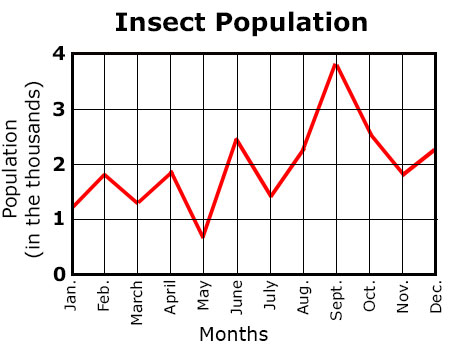Learn
Reading Graphs
Look at the line graph below. You should be able to identify the title and axes. The x-axis always runs horizontally and the y-axis always runs vertically. Each axis is labeled with evenly spaced units. The units give you the measurements for points on a graph.

When you read any graph, follow the following steps:
- Look at the graph title. What is the graph about? This graph describes the population of insects in a particular area.
- Look at the x-axis and y-axis (together they are referred to as the axes).
- What units are used in the graph?
- What quantities do they measure?
- In this graph, the y-axis measures the population of insects by the thousand. The x-axis measures time in months.
- Read the key or legend, if the graph has one. A key or legend will explain colors, abbreviations, or symbols used in the graph. This graph does not have key or legend.
- Look at the graph and try to interpret it.
- See if the lines go up or down between two points.
- Notice how steep a line is. The steeper the line is, the faster the variables are changing.
- In this graph, the insect population seems to fluctuate between January and July before growing rapidly in August and September. After September, the insect population drops.
Points on a Graph
Finding the value for a point on a graph is very simple. For example, imagine that you are asked to find the change in the population of the world in 1990 on the graph below.

Source: U.S. Census Bureau
To determine this, follow these steps:
- Begin by finding the year 1990 on the graph.
- Trace the gridline for 1990 up to the line depicting population change.
- Then, trace that line horizontally over to the y-axis.
- The point is about halfway between 90 and 80 million, so the population change of the world in 1990 was about 85 million. When points are between gridlines, you may have to estimate the point's value.
What if you were asked to find the years at which the population change was 65 million? In this case:
- Start by finding 65 million on the y-axis.
- Follow this line horizontally across until it intersects with the population change line.
- Trace down to find the value for this point on the y-axis.